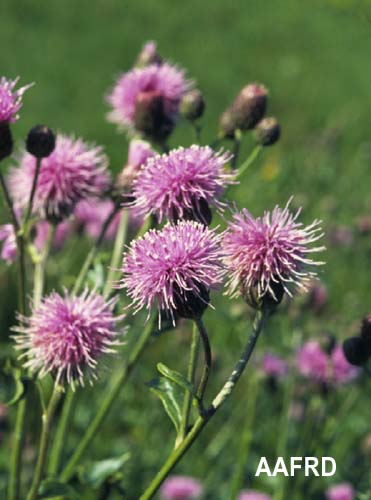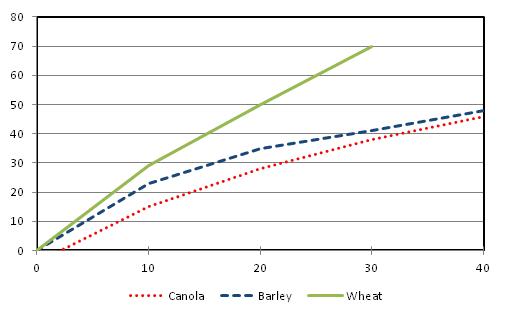| | Canada Thistle
Cirsium arvense
Life Cycle | Emergence | Flowers | Reproduction | Competition | Management Strategy | Control Mechanisms
Life Cycle
A persistent perennial, reproducing mainly by horizontal roots and by seed
Emergence
Shoots from horizontal roots appear on the soil surface around mid-April and continue to emerge throughout the summer.
Seeds germinate from late May through to fall. Seedling plants can be distinguished from re-growth from presence of cotyledons.
Flowers

Flowers appear in mid-June and continue into September.
Reproduction
Seed
Seed can germinate eight to ten days after flowering. New seed will germinate readily, as conditions allow, or they can go dormant for up to twenty years. A key feature of Canada thistle that it is dioecious (having separate male and female plants). Although both male and female plants produce flowers, only female flowers produce seed. Male and female plant proximity will determine levels seed production. Despite Canada thistle having a pappus for wind dispersal, research has shown that only 10% of pappus had the seed still attached after 10 meters of travel.
Although Canada thistle is a prolific seed producer (about 45 viable seeds/flower), control efforts should be aimed mainly at vegetative reproduction, as seed is not its most effective means of spread.
Vegetative
New roots, which develop from old roots, continually replace weak or dead roots. Horizontal growth is rapid and roots can regenerate from small pieces (0.6 cm long). New aerial shoots arise from buds present on the abundant horizontal roots. In one year, a single plant may extend over a curricular area, 6.1 m in diameter. Infestations can develop quickly. Thirty four days after emergence, a seedling may be only at the three-leaf stage but it may have already developed an extensive root system with numerous buds on the roots. New seedlings can still develop from the root buds if the original shoot was killed. On average, 8 shoots can originate per meter of root. A one-year old established plant can have more than 200 buds on its root system.
Root fragments have enough sufficient reserves to survive for 100 days under adverse conditions. This is why systemic herbicides are more effective in control as they are translocated to the root system.
Begin control measures to starve roots when flowering begins in early to mid-June, at the low point of food reserves in the roots.
Competition
Canada thistle is extremely competitive. However, established perennial forages compete well, provided they are cut twice each year.
The following chart shows estimated yield losses of canola, barley and wheat caused by Canada thistle. Actual yield losses may vary from year to year depending on climatic conditions.
% Yield Loss

 | Canada thistle density (# per sq. meter) |
Management Strategy
Eradication of Canada thistle will require continuous control practices for more than one season, and a combination of methods to be successful in control.
Root starvation is the key to controlling Canada thistle, control of seed production is secondary.
Control Mechanisms
Prevention
Prevention of plant establishment and spread are an important step in control. Use clean seed, purchase clean feed, cover grain trucks, clean equipment and monitor fencelines or roadsides for invasions.
Tillage
Tillage can be effective when used repeatedly to deplete root reserves enough to kill plants. The above ground must be continually removed before it has a chance to replenish root reserves.
Summer fallow - The principles of root starvation apply in controlling Canada thistle in summer fallow. Canada thistle should be allowed to have more than a week’s growth before the next shallow tillage operation on summer fallow. Control measures will need to continue when the land is seeded to a crop.
Pre-seeding tillage - Tillage prior to or at seeding will cut emerging thistle shoots and set them back slightly.
Fall tillage - Fall tillage is important because food reserves will increase otherwise. Begin tillage of annual crops as soon as possible after harvest. If moisture conditions allow, repeat tillage when shoots reach 10 cm until freeze-up. Avoid tillage in wet conditions as root pieces are more likely to survive. Erosion concerns will have to also be considered when implementing repeated tillage.
Rotation
Oilseeds and specialty crops generally do not compete well on land infested with Canada thistle. Fall rye and winter wheat offer fall competition and weaken late fall thistle infestations. Annual cereals can be used in rotation if they are planted early and if land is tilled in the fall after cereals are removed.
Seeding
Early seeding allows cereals to compete better with Canada thistle. Seed perennial crops, such as alfalfa and crested wheatgrass, slightly heavier than normal and into moist soils to encourage strong emergence.
Mowing
Mowing is effective on summer fallow and eliminates the risk of erosion from tillage. If done every three to four weeks from June through September, the weeds will become weakened. Thistles die out eventually in perennial forages that are cut twice or more each year.
Biological control
It has been difficult to find biological control agents for Canada thistle since they either fail to survive or are not specific enough to Canada thistle to release.
Four bio-control agents are established in Canada: the stem gall fly, Urophora cardui, the stem weevil, Hadroplontus litura, the defoliating beetle, Lema cyanella, and the seed-head weevil Rhinocyllus conicus.
The thistle is also attacked by six adventitious and one native insect: the root-crown weevil Cleonis pigra, the defoliating beetle Cassida rubiginosus, the seed-head weevil Larinus planus, the seed-head fly, Terellia ruficauda, the systemic rust fungus, Puccinia punctiformis, and a small midge with yellow-orange larvae Dasineura gibsoni that feeds on the seed hairs. Finally, there is the native painted lady butterfly, Vanessa cardui, and over 70 general feeders. In spite of the plethora of enemies, the thistle is still a problem.
Chemical Control
There are 138 registered products and 457 registered mixes that work on Canada thistle. Details on herbicides can be found in our Herbicide Selector database on ARD’s Ropin’ the Web. |
|